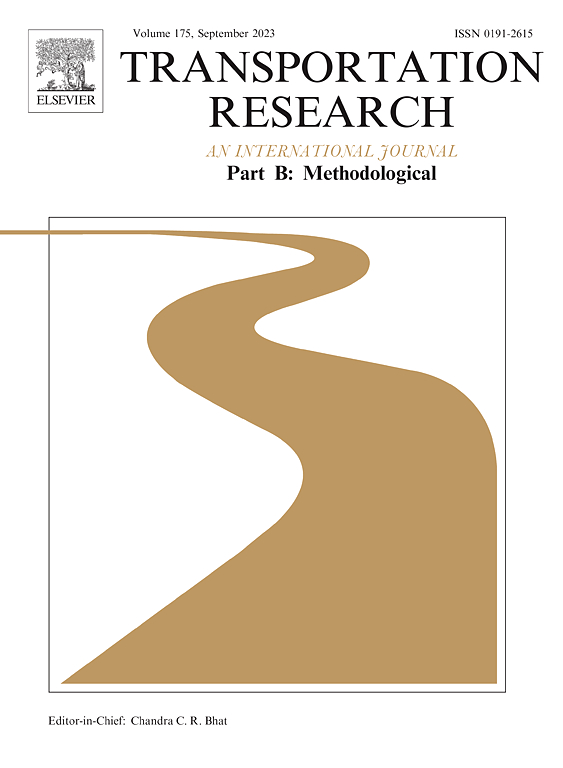多车道交通的扩展宏观节点模型
IF 6.3
1区 工程技术
Q1 ECONOMICS
引用次数: 0
摘要
在宏观分配模型中,交通流通过网络加载模型被分配到网络中。网络加载通过链路模型沿着链路传播流,并通过节点模型通过交叉点或交叉点传播流。大多数交通延误是由于在路口或交叉路口排队造成的,特别是在城市网络中。因此,底层节点模型的效率和准确性对于捕获这些延迟(和流)至关重要。现有的基于链路的宏观节点模型简化了先入先出(FIFO)在链路级别的假设,当一条链路在交叉口或交叉路口附近有多条进近车道时,这通常是不现实的。在这项工作中,我们建议放宽这一假设,使FIFO在运动水平上保持不变。我们通过开发几个模型扩展来实现这一点。首先,提出了一种新的基于车道的节点模型。其次,我们提出了一个均衡问题和一个将发送流分配到车道的通解算法。这使我们能够明确地考虑包含有关十字路口或交叉路口布局的重要信息的接近车道配置。我们证明了传统的基于链路的节点模型是我们新提出的模型的特殊情况,即每个进路车道都允许所有可能的运动。提供了各种数值示例,演示了所建议的节点模型扩展的功能。本文章由计算机程序翻译,如有差异,请以英文原文为准。
Extended macroscopic node model for multilane traffic
In a macroscopic assignment model, traffic flows are distributed onto the network by means of a network loading model. The network loading propagates flows along links via a link model and through junctions or intersections via a node model. Most of the travel time delays are caused by queues forming at junctions or intersections, especially in urban networks. Therefore, the efficiency and accuracy of the underlying node model is paramount in capturing these delays (and flows). Existing link-based macroscopic node models make the simplifying assumption that first-in-first-out (FIFO) holds at the link level, which is often unrealistic when a link has multiple approach lanes near an intersection or junction. In this work we propose to relax this assumption such that FIFO holds at the movement level. We do so by developing several model extensions. First, a novel lane-based formulation of the node model is proposed. Secondly, we formulate an equilibrium problem and a general solution algorithm to allocate sending flows to lanes. This allows us to explicitly consider approach lane configurations that contain important information about the layout of an intersection or junction. We show that the conventional link-based node model is a special case of our newly proposed model in case each approach lane on an incoming link allows all possible movements. Various numerical examples are provided, demonstrating the capabilities of the proposed extensions to the node model.
求助全文
通过发布文献求助,成功后即可免费获取论文全文。
去求助
来源期刊
CiteScore
12.40
自引率
8.80%
发文量
143
审稿时长
14.1 weeks
期刊介绍:
Transportation Research: Part B publishes papers on all methodological aspects of the subject, particularly those that require mathematical analysis. The general theme of the journal is the development and solution of problems that are adequately motivated to deal with important aspects of the design and/or analysis of transportation systems. Areas covered include: traffic flow; design and analysis of transportation networks; control and scheduling; optimization; queuing theory; logistics; supply chains; development and application of statistical, econometric and mathematical models to address transportation problems; cost models; pricing and/or investment; traveler or shipper behavior; cost-benefit methodologies.

 求助内容:
求助内容: 应助结果提醒方式:
应助结果提醒方式:


